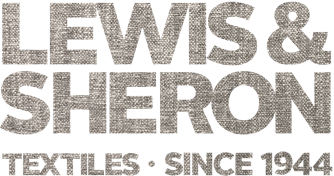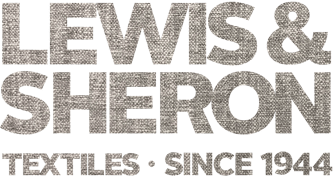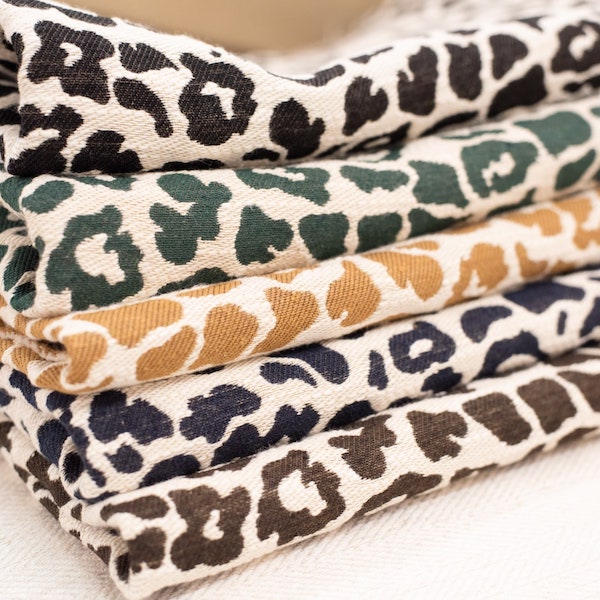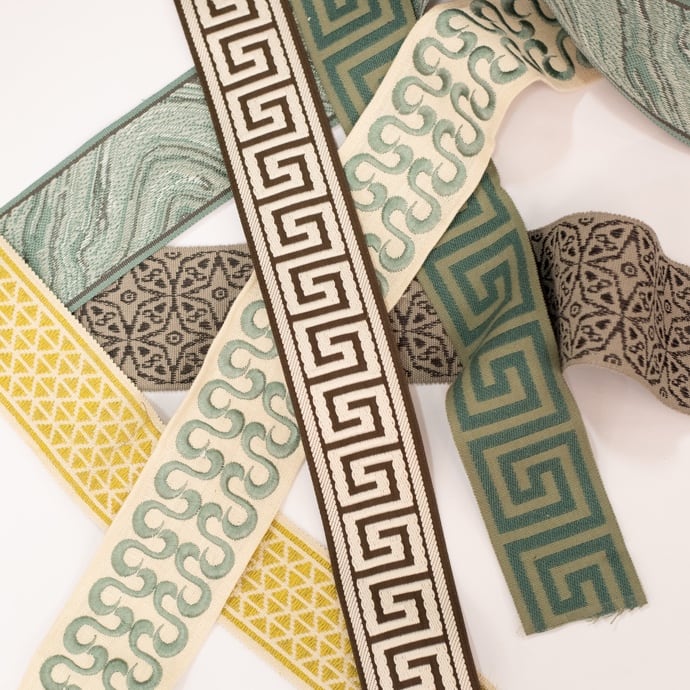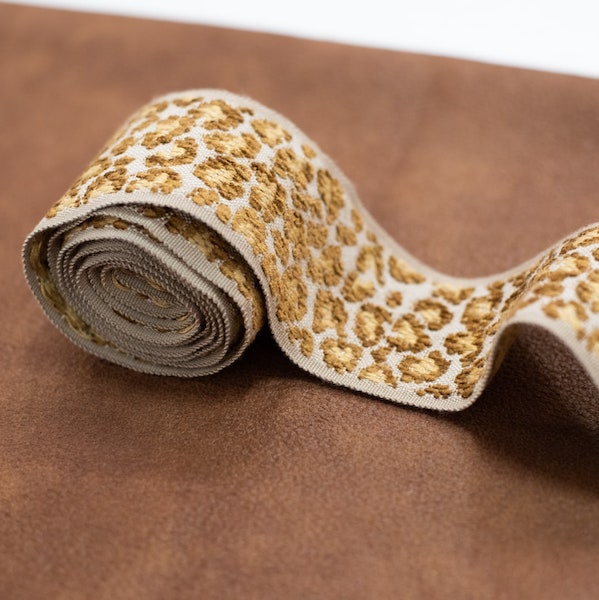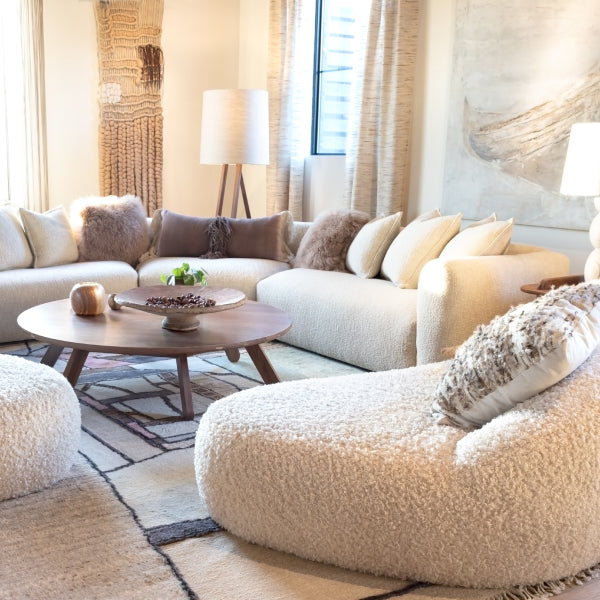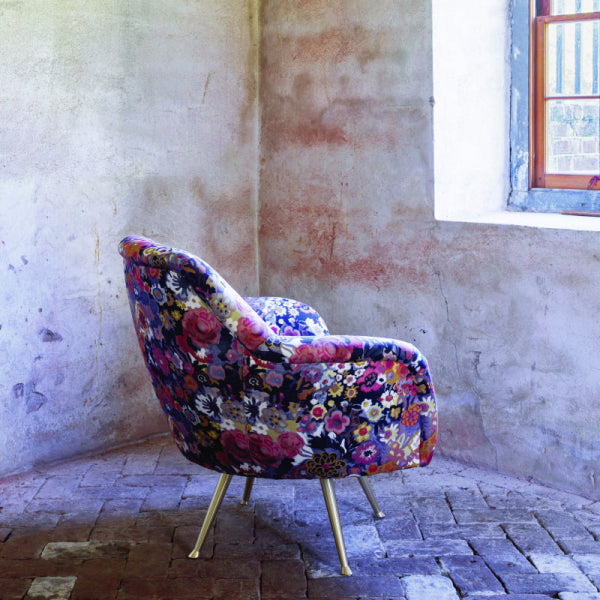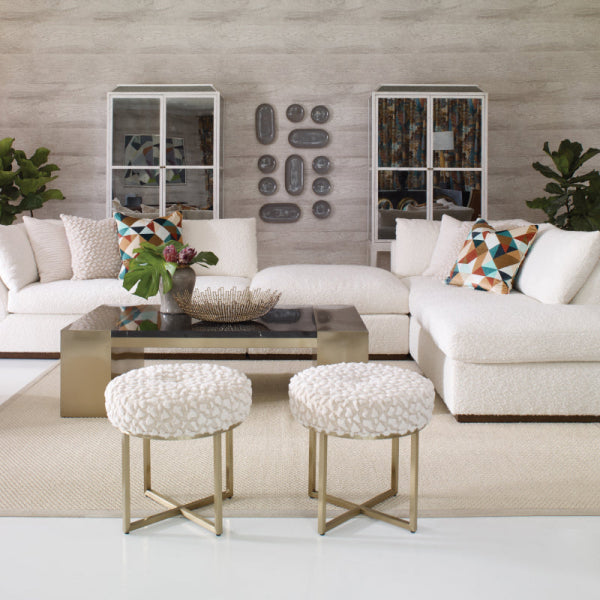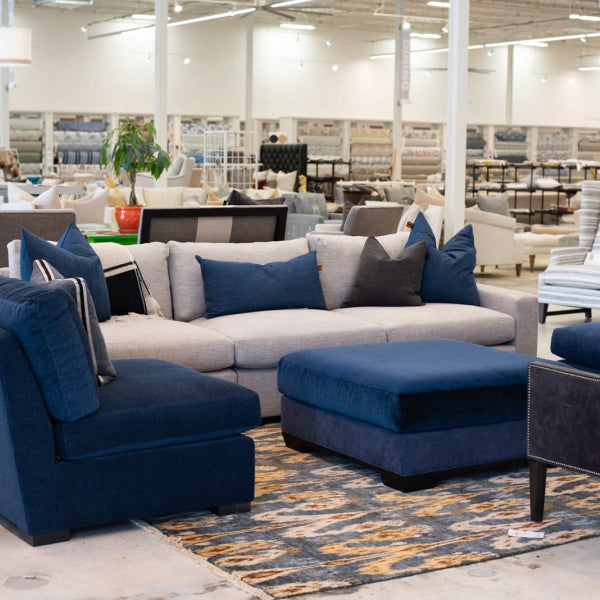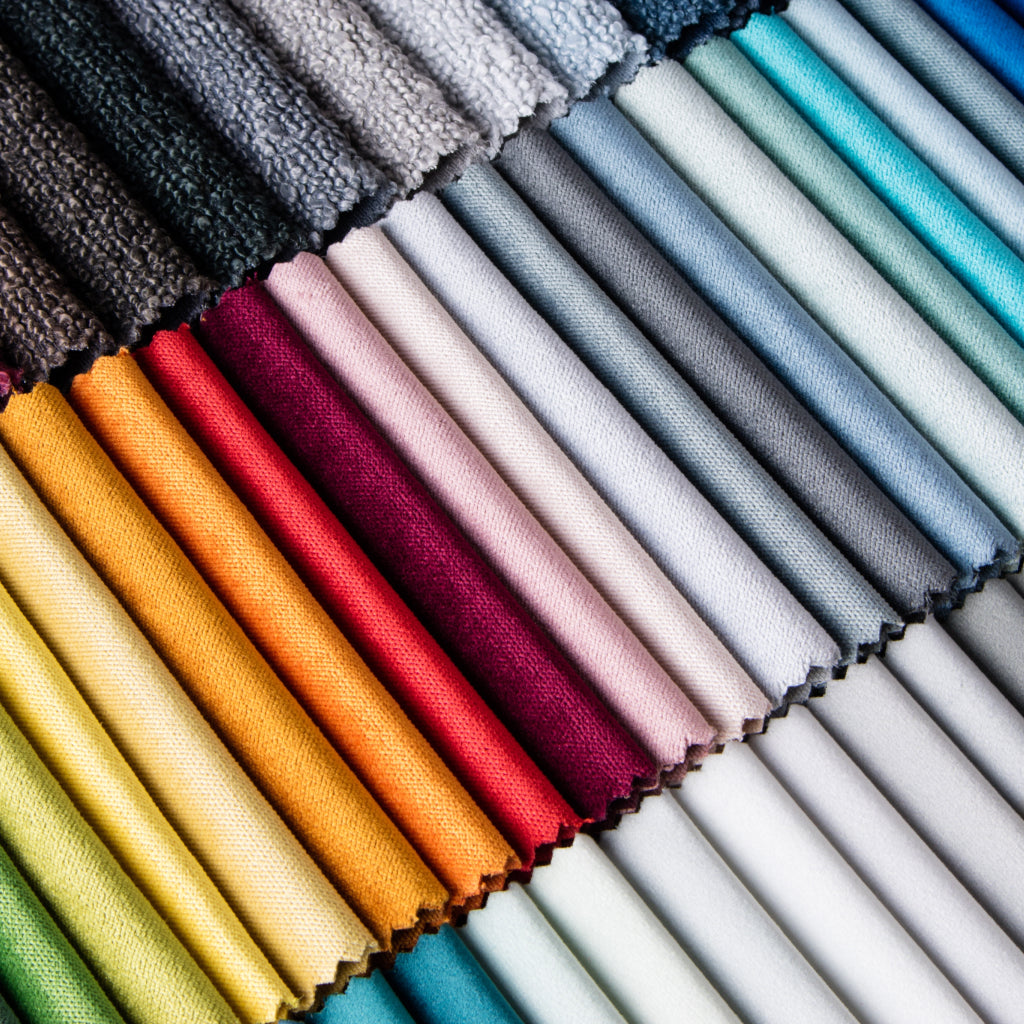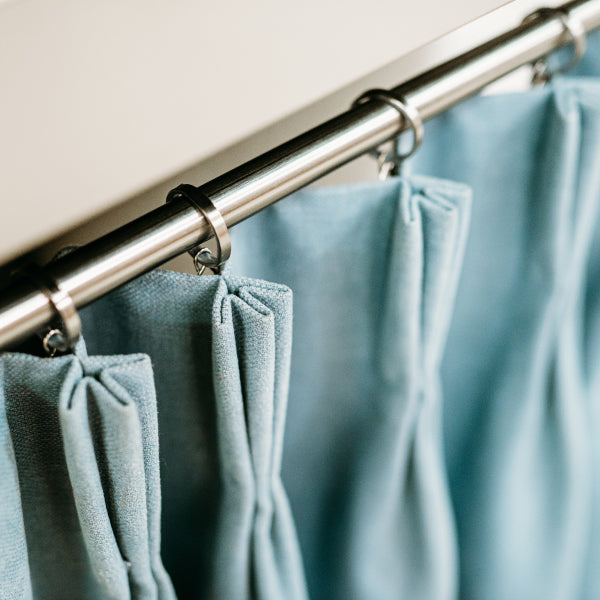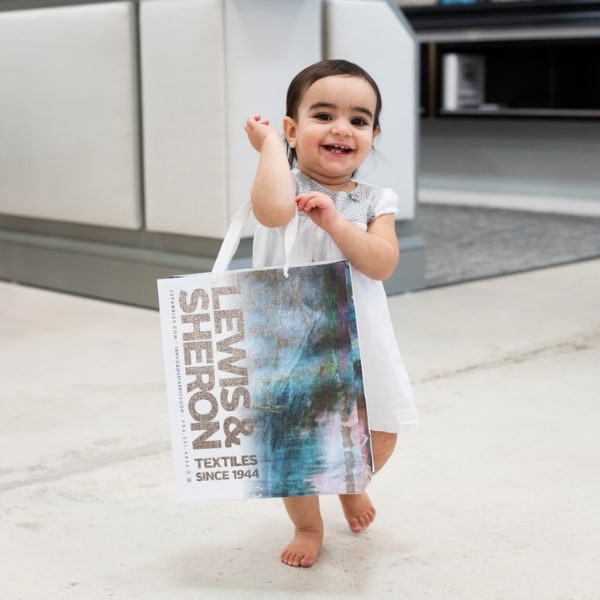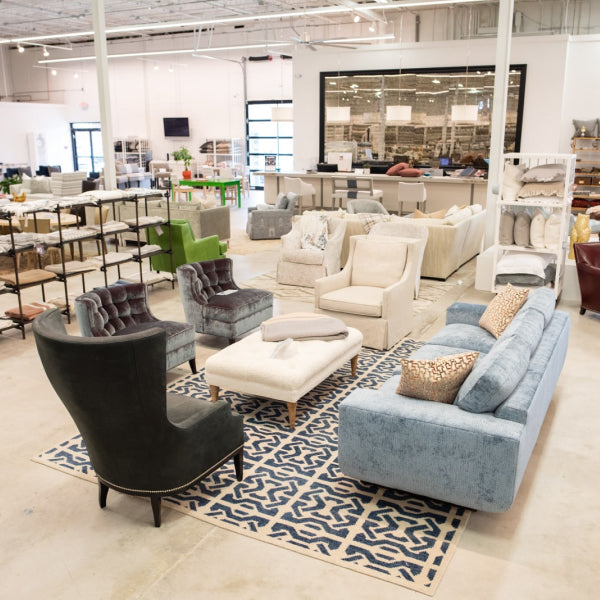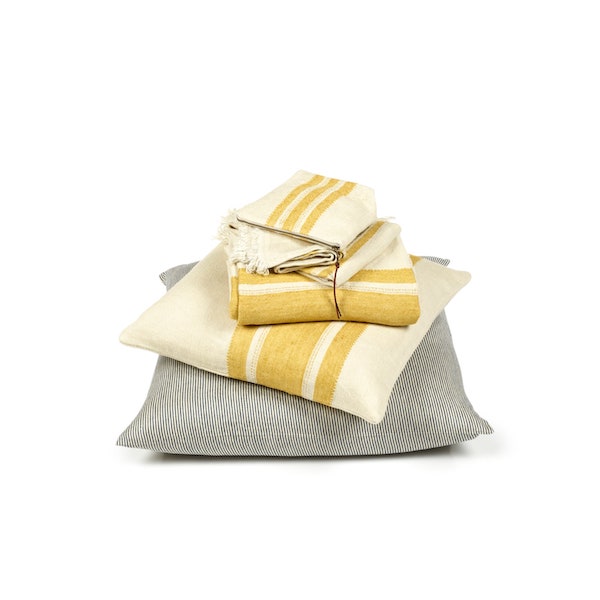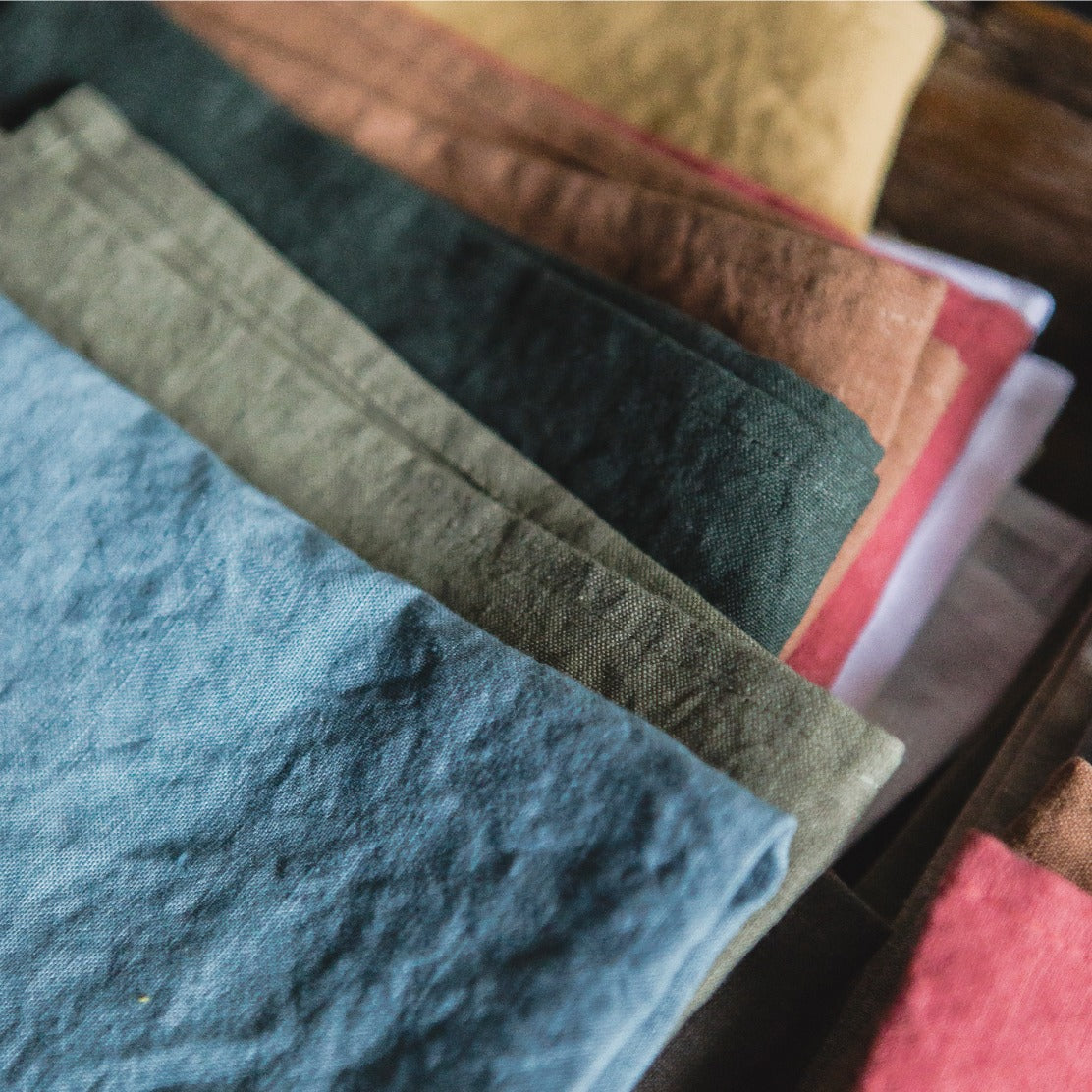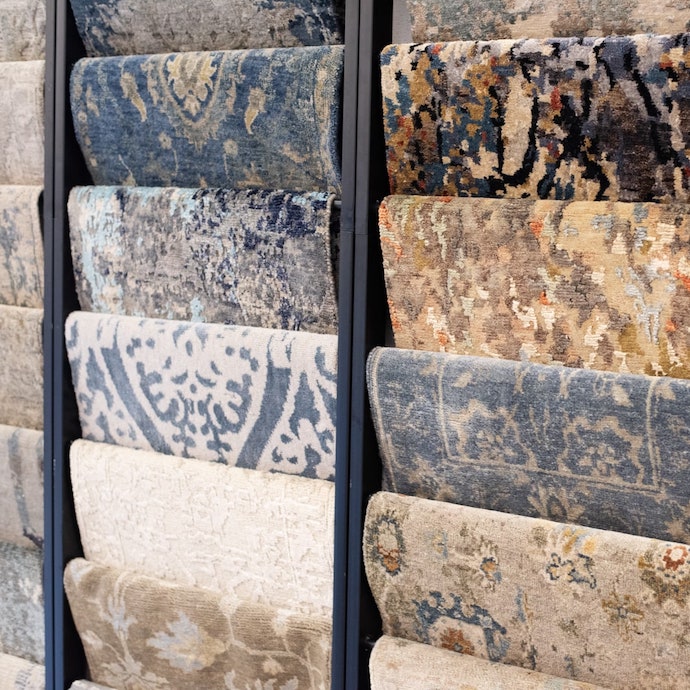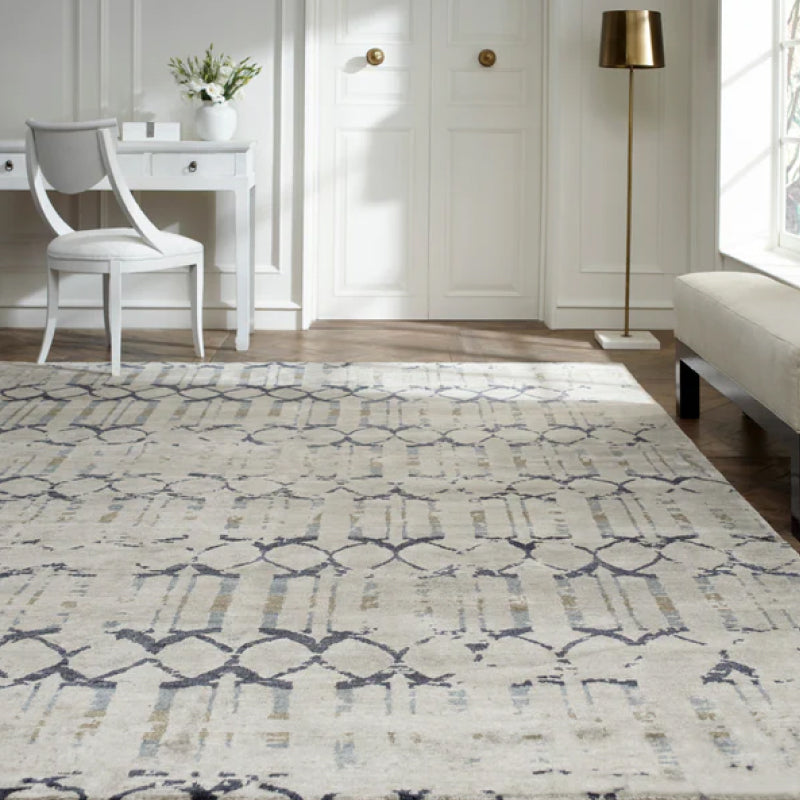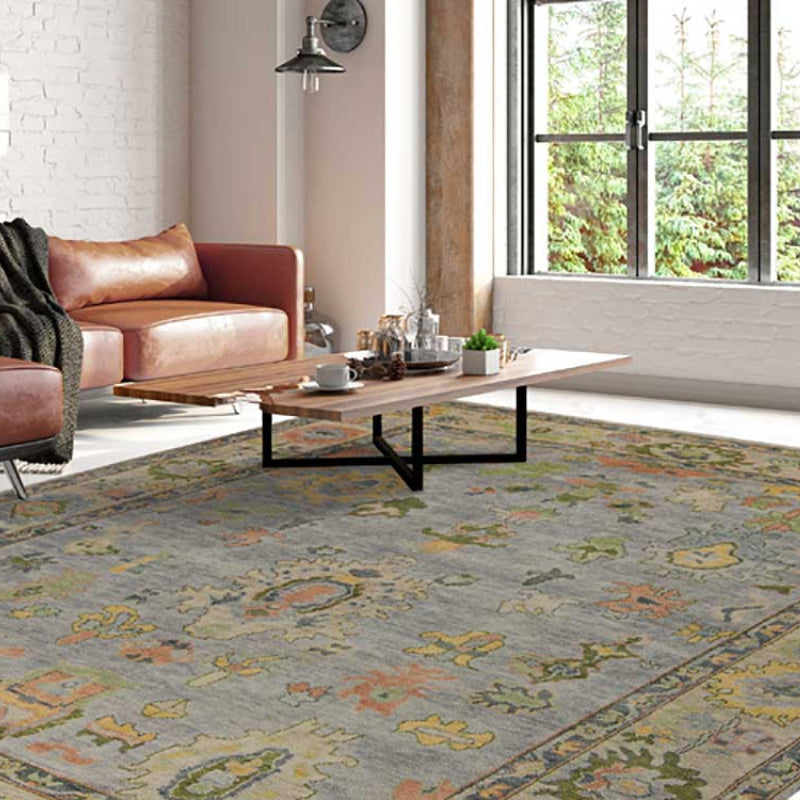Choosing the right upholstery fabric is the single most important decision you'll make for your furniture. It goes deeper than just picking a color you like—it’s about crafting an experience, ensuring your investment lasts, and making a statement that truly endures. Let's get you thinking like a designer.
The Art of Choosing Upholstery Fabric in Atlanta
Step inside our Buckhead showroom, and you’ll understand why Lewis and Sheron has been Atlanta’s destination for exquisite furniture and fine fabrics for decades. From the handcrafted lines of a Verellen sofa to the curated textures of a Wesley Hall sectional, every piece tells a story of quality, comfort, and design mastery.
This is where the magic happens. But before you fall for a pattern, it’s smart to understand the principles behind a great fabric choice. We’re here to help you decode the language of textiles so you can find that perfect balance between your lifestyle and timeless style.
Whether you’re outfitting a high-traffic family room in Roswell or a sophisticated sitting area on West Paces Ferry, the right custom upholstery is what transforms a house into a home.
More Than Just a Pretty Face
Picking upholstery isn't a small decision. The global market, valued at over $13.5 billion, is on track to hit nearly $18 billion by 2031. It's clear people are wisely investing in longevity and comfort, with a growing appetite for sustainable, high-performance options.
This shift proves that homeowners and designers want lasting value, not just fleeting trends. You can dive deeper into the latest upholstery fabric trends to see how the market is evolving.
The best fabric choice is a conversation between your home’s aesthetic and your daily life. It needs to be beautiful, yes, but it also needs to work for you.
That’s our core philosophy. We help you navigate the vast world of fine fabrics, whether it's for an Ambella accent chair that needs a pop of texture or a sprawling Lee Industries sofa built for family movie nights in Marietta.
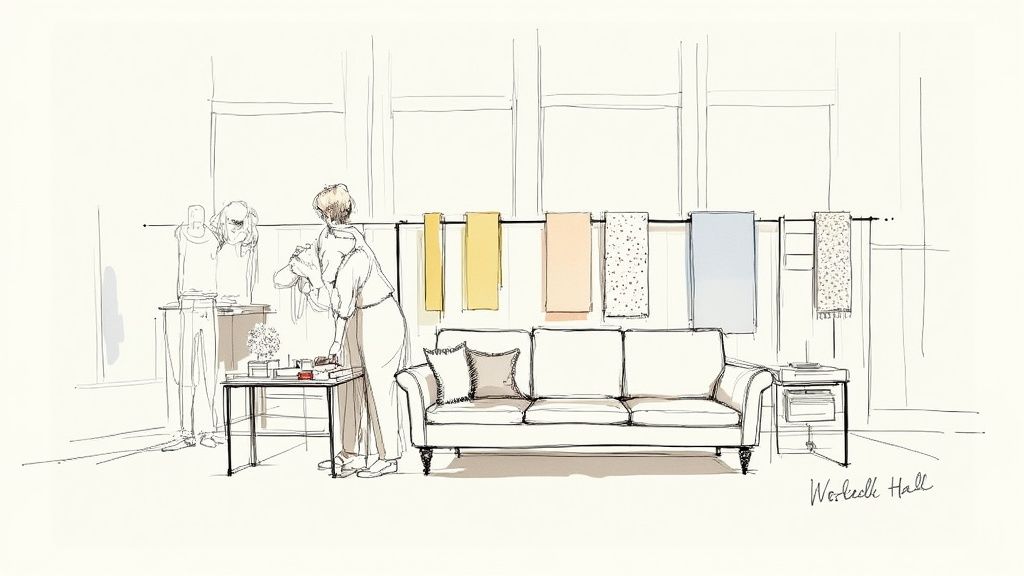
What to Consider First
Before you start pulling bolts of fabric, let's lay some groundwork. The key to a confident decision is answering a few foundational questions right from the start. This ensures your investment not only looks stunning on day one but performs beautifully for years.
We've put together a quick-glance table to guide your thinking.
Key Fabric Considerations at a Glance
| Consideration | What It Means for Your Furniture | Key Questions to Ask |
|---|---|---|
| Lifestyle Assessment | How the furniture will really be used dictates its durability needs. | Do I have kids or pets? Is this for a formal room or daily lounging? How often do we host guests? |
| Location in the Home | Where the piece lives affects its exposure to sun, spills, and wear. | Will it be in a sunny room? Is it near a high-traffic area like a hallway or kitchen? |
| Longevity Goals | Your expectations for the furniture's lifespan should match the fabric's quality. | Am I updating a trendy piece, or reupholstering an heirloom to last a generation? |
| Maintenance & Cleaning | Some fabrics require more care than others. | How much upkeep am I willing to do? Do I need something I can spot-clean easily? |
Thinking through these points first makes the selection process smoother and far more successful.
Let’s break these down:
- Real Life Use: How is this furniture actually going to be used? Be honest. Think kids, pets, entertaining. A formal living room in Milton has different demands than a busy den in East Cobb where everyone piles on the sofa.
- Location, Location, Location: Will the piece sit in a sun-drenched room? Fade resistance is a huge factor for homes in Alpharetta or anywhere in North Georgia where natural light is a major feature.
- How Long Should It Last? Are you updating a trendy piece or reupholstering a precious family heirloom? The fabric's durability should align with the furniture's intended lifespan.
Our Atlanta fabric showroom is one of the top Atlanta interior design resources, helping you connect these practical needs with our incredible designer fabric collections. By starting here, you’re already on the path to a choice you’ll love for years.
Decoding Durability for a Life Well Lived
Let’s be honest, furniture should be for living in, not just looking at. Real luxury isn't a stiff, museum-quality piece you're afraid to touch. It's a high-performance textile that can handle your life—the difference between a sofa that’s a beautiful decoration and one that invites you to kick your feet up.
When clients visit our Atlanta showroom, we can talk metrics like Wyzenbeek rub counts all day. But the real conversation always starts with your lifestyle. Kids? Golden Retrievers? Friday night get-togethers?
The fabric needed for a stunning Wesley Hall sofa in a busy East Cobb family room is worlds away from what you'd choose for a delicate Lee Industries chair in a formal Buckhead study. One needs to shrug off spills; the other just needs to look exquisite. This is where we find that perfect intersection of practical and plush.
Understanding the Wyzenbeek Test
You'll hear the term Wyzenbeek test (or "double rubs") when you talk about durability. Think of it as a stress test for fabric. A machine literally rubs heavy cotton back and forth across the textile until two yarns break.
Here's a quick guide to what those numbers mean:
- Under 10,000 Double Rubs: Delicate fabrics. Think decorative pillows that won't see much action.
- 10,000 to 15,000 Double Rubs: A solid choice for light use, like a formal sitting room chair in a quiet Milton home.
- 15,000 to 30,000 Double Rubs: Heavy-duty for residential use. The sweet spot for most family room sofas and chairs.
- Over 30,000 Double Rubs: Commercial-grade territory. A fantastic option for that one piece of luxury furniture in Atlanta that gets all the love.
A high rub count is a great indicator of abrasion resistance, but it isn't the whole story. A textile's fiber content, weave, and finish all play a huge role.
Beyond Rub Counts: Pilling and Cleaning Codes
Durability is more than just friction. A fabric can have a sky-high rub count but still be a nightmare if it starts pilling or is impossible to clean.
Pilling is when those annoying little balls of fiber pop up. It's caused by friction and is more common in fabrics made from shorter, spun yarns. Tightly woven fabrics and long-staple fibers are far less likely to pill.
Then you have the cleaning codes—your roadmap to maintenance. You’ll find these on the back of every fabric sample:
- W: Use water-based cleaners. Easy.
- S: Solvent-based cleaners only. Water can damage these.
- W/S: Use either water or solvent-based cleaners. Versatile and great.
- X: Vacuum only. No water, no solvents. For the most delicate textiles.
Knowing these codes from the start can save you a world of heartache. It's a crucial part of figuring out how to select the best fabric for reupholstering a sofa.
The Rise of Performance Fabrics
Today's performance fabrics are game-changers. Forget the stiff, plastic-feeling outdoor fabrics of the past. Modern designer lines from Crypton and Sunbrella offer incredible stain resistance, fade resistance, and cleanability without sacrificing a soft, luxurious feel.
These textiles are engineered to repel spills, making them the perfect choice for luxury furniture in Roswell homes with kids or pets. A red wine spill on a light-colored performance fabric sofa is no longer a catastrophe; it’s a minor inconvenience you can blot away.
The demand for these textiles has exploded. The commercial sector, which drives innovation, accounts for nearly 35% of total upholstery fabric sales. This has pushed manufacturers to create textiles with antimicrobial and fire-retardant properties—now standard in 60% of commercial fabrics. As designers and homeowners in Alpharetta and Buckhead seek better long-term value, this technology is becoming a staple in fine home fabrics.
The Language of Fibers: Natural Versus Synthetic
Every fabric has a story, starting with its fibers. Are you drawn to the organic feel of natural materials, or do you need the bulletproof performance of a modern synthetic? This choice shapes how your furniture looks, lives, and feels.
When you walk through our Atlanta fabric showroom, you can run your hand over the cool, crisp surface of a Belgian linen, feel the familiar softness of a classic cotton, or get lost in the rich depth of a plush velvet. Natural fibers have an undeniable soul—a character synthetics can only aspire to replicate.
But then there are the workhorses: the performance synthetics. We’re talking sophisticated acrylics and durable polyesters, engineered to fight off stains, resist fading, and stand up to daily life. These are the smart, pragmatic choices for a sun-drenched room in Alpharetta or a family-friendly custom sofa in Marietta.
Often, the real magic happens in the blend. A thoughtfully crafted cotton-linen mix gives you the best of both worlds. Understanding these subtleties is what gives you the confidence to talk shop like a pro, whether you’re with us or at a high-end furniture store in Buckhead.
The Charm of Natural Fibers
Sourced from plants and animals, natural fibers bring an authentic, grounded feeling to an interior. They are the backbone of so many designer fabric collections.
- Linen: Casual elegance. Exceptionally strong, breathable, and perfect for a relaxed, airy atmosphere. Yes, it wrinkles—designers call that character.
- Cotton: The ultimate chameleon—soft, versatile, comfortable. It takes dye beautifully, offering an endless world of colors. A solid choice, though it can stain if not treated.
- Wool: A durability champion. Naturally flame-retardant, resilient, and fantastic at resisting pilling. It brings incredible texture and warmth.
- Silk and Velvet: The height of luxury. Silk gives a delicate shimmer, while velvet has a deep pile that plays beautifully with light. Best for formal, low-traffic pieces.
A common myth: natural fibers are always delicate. The truth is, a tightly woven Belgian linen or a dense wool can easily outperform a flimsy synthetic. Construction matters.
The Power of Performance Synthetics
Forget the stiff synthetics of the past. Today’s performance fabrics are engineered for real life, a favorite for designers creating beautiful and functional spaces from Roswell to Forsyth County.
Leaders like polyester, acrylic, and olefin are often solution-dyed, meaning color is an integral part of the fiber. This gives them incredible resistance to fading, even in the brightest Georgia sun.
They’re also masters at repelling stains and moisture. It’s why you’ll find them on Wesley Hall sofas or Lee Industries chairs destined for busy family rooms. They deliver peace of mind without sacrificing a soft hand-feel.
Your daily life is the ultimate guide. The goal is to find a fiber that not only looks incredible but also holds up to everything you throw at it.
To make it even clearer, here is a simple breakdown comparing the most common fibers.
Natural vs. Synthetic Fiber Performance Guide
This head-to-head comparison of common upholstery fibers will help you choose the best material for your lifestyle.
| Fiber Type | Best For | Key Considerations (Durability, Fading, Cleaning) |
|---|---|---|
| NATURAL | ||
| Linen | Relaxed, airy spaces; casual elegance. | Strong, but wrinkles easily. Prone to staining if not treated. Good fade resistance. |
| Cotton | Versatile everyday use; comfortable seating. | Can stain and fade in direct sun. Tightly woven cottons are more durable. |
| Wool | Cozy, high-traffic areas; family rooms. | Extremely durable, resists pilling and wrinkling. Naturally flame and soil resistant. |
| Silk | Formal, low-traffic accent pieces. | Delicate. Very susceptible to sun damage and moisture. Professional cleaning required. |
| SYNTHETIC | ||
| Polyester | High-traffic, family-friendly furniture. | Excellent durability and fade resistance. Resists wrinkling and stains. Easy to clean. |
| Acrylic | Outdoor furniture; sunny rooms. | Unbeatable resistance to fading and moisture. Can pill if not a high-quality blend. |
| Olefin | Extreme-use areas, indoors and out. | A workhorse. Exceptional stain, moisture, and fade resistance. Very durable. |
| Nylon | Blended with other fibers for strength. | Rarely used alone, but adds incredible durability and resilience to other fabrics. |
Ultimately, this table shows there's no single "best" fiber—only the best fiber for your project.
Finding the Perfect Balance
So, which path should you take? It's rarely a black-and-white choice. Many of the most stunning textiles we carry from top vendors like Verellen and Ambella Home are sophisticated blends.
A little polyester woven into a cotton fabric can dramatically increase its durability without sacrificing its soft feel. A touch of viscose can lend a subtle, silk-like sheen. These thoughtful combinations create fabrics that are truly exceptional.
In the end, understanding fibers is about matching material to mission. Whether you’re a designer in our Trade Program or a homeowner, our job is to help you translate that mission into a tangible, beautiful reality. We're here to help you find the perfect fine fabrics in Alpharetta that speak to both your design dreams and your daily life.
Mastering Pattern, Color, and Texture
This is where the real fun begins. A fabric that looks stunning on the bolt can either overwhelm a room or get completely lost on a piece of furniture. It’s a delicate dance of scale, light, and feel—and getting it right is the secret to a truly personal interior.
The most important concept here is scale. A pattern's size has to complement the furniture's size and shape. Imagine a sprawling floral on a grand Verellen sectional in a spacious Buckhead living room—majestic. Now picture that same fabric on a petite Ambella accent chair—it would swallow the piece, looking chaotic.
On the other hand, a tiny, intricate pattern might just read as a solid color from across the room, losing its personality on a large sofa. It’s all about proportion. Think of it like dressing a person; you choose prints that flatter the frame. The same principle applies to your furniture.

How Texture and Light Transform Color
Color is never just one thing; it’s a living element that shifts with its surroundings. This is where texture comes in, dramatically influencing how we perceive a hue.
A deep navy velvet absorbs light, creating shadows that make the color feel darker and more luxurious. But render that same navy in a smooth, reflective silk, and the color suddenly appears brighter, almost electric, as it bounces light.
This is a conversation we have every day in our Buckhead showroom. We always encourage clients to take fabric samples home.
Your home’s lighting is the final ingredient. A fabric that looks perfect under bright showroom lights might reveal different undertones in the warm afternoon sun of your Roswell home or the cool morning light of a room in Alpharetta.
The Designer’s Guide to Mixing and Matching
Creating a layered, sophisticated look is about confidently mixing patterns, solids, and textures. The goal is a room that feels collected and personal, not chaotic. Here are a few designer-approved strategies:
- Vary the Scale: This is the key. Pair a large-scale print (a bold floral on a sofa) with a medium-scale geometric (on chairs) and a small-scale, subtle pattern (for pillows).
- Find a Common Thread: Tie your chosen fabrics together with a unified color palette. Even wildly different patterns feel harmonious if they share one or two common colors.
- Balance with Solids: Give the eye a place to rest. Not every piece needs to scream for attention. A solid Wesley Hall sofa can be the perfect anchor for more adventurous Lee Industries chairs.
To go deeper on how hues affect a room's mood, it's worth exploring the techniques for mastering home design color. This knowledge is essential for building a space that feels cohesive.
Ultimately, mastering these elements is about telling a visual story. It's about creating harmony and interest. This is your chance to infuse your personality into your home, creating a space that is uniquely and beautifully yours.
Bringing Your Vision to Life at Lewis and Sheron
Finding the perfect designer fabric is an amazing feeling, but it's only the beginning. The real magic starts when we help you bring that vision home. At Lewis and Sheron, we live for that moment—bridging the gap between a bolt of fabric and a bespoke piece of furniture you'll cherish.
Our Buckhead showroom is more than a store; it’s one of Atlanta’s essential resources for interior design. For decades, discerning homeowners and top designers from Milton to Marietta have trusted us to execute their visions with an artist’s touch. This is where your dream Wesley Hall sofa or custom Lee Industries chair stops being an idea and starts becoming a reality.
From Swatch to Sofa: The Custom Upholstery Process
So, you’ve found the one. What’s next? Think of it as a creative partnership between you, our design experts, and our world-class furniture makers.
We have deep relationships with premier American-crafted furniture brands like Verellen, Wesley Hall, and Ambella. This isn't about picking from a catalog; it's about building something uniquely you. From frame depth to cushion fill, every detail is considered, all wrapped in the exquisite fabric you’ve hand-selected from our designer fabric collections.
Our process is effortless for you:
- Consultation: It starts with a conversation. Bring your ideas and photos to our Atlanta fabric showroom.
- Selection: We’ll help you confirm your fabric choice is the perfect match for the furniture and your lifestyle.
- Yardage Calculation: Our team calculates the precise amount of fabric needed, accounting for pattern repeats, welting, or tufting. No costly guesswork.
- Creation: We handle all coordination, sending your fabric directly to our vendors to be expertly applied to your new custom piece.
We manage the moving parts so you can enjoy the excitement of watching your vision come together.
An Invaluable Resource for Atlanta’s Design Community
For interior designers, time and access are everything. We built the Lewis and Sheron trade furniture program specifically to support Atlanta’s dynamic design community. We’re not just a supplier; we’re a dedicated partner, invested in your success.
Our Trade Program offers designers an inside track to exclusive textiles and fine fabrics, from Alpharetta to Buckhead. It’s a partnership designed to give you a competitive edge with special pricing, dedicated support, and access to a curated collection of luxury furniture Atlanta clients simply won’t find elsewhere.
At Lewis and Sheron, creating beautiful interiors should be as inspiring as the final result. Our role is to be your most reliable, creative, and knowledgeable resource in Atlanta.
The Smart Approach to Heirlooms and Updates
Not every project begins with a blank slate. Sometimes, the goal is to breathe new life into a piece with history. Reupholstery is an art form—a sustainable choice that honors a piece's story while updating it for today. Whether it’s an heirloom or a vintage find, our reupholstery services connect you with Atlanta’s finest craftspeople.
If you're thinking about this route, our guide on how to reupholster furniture is packed with valuable insights.
This focus on quality and longevity is resonating. The global luxury upholstery fabric market is on track to hit USD 10.7 billion by 2032, fueled by a growing demand for high-end, sustainable materials. In fact, 55% of North American consumers now say sustainability is a key factor. The trend is even stronger among younger homeowners, with 70% of millennials and Gen Z willing to pay a premium for fabrics from recycled or organic materials.
Whether you're commissioning new high-end furniture in Buckhead or reviving a classic in West Paces Ferry, our team is here to guide you. From ordering samples to coordinating shipping, we’ll make sure your project is a seamless success.
Common Questions About Choosing Upholstery Fabric
We get it. The world of fine fabrics is vast, and making that final decision can feel like a huge commitment. It’s why our design experts in the Buckhead showroom are here to be your guide. We've gathered the most common questions right here to give you that last bit of clarity.
Think of this as a conversation with one of our in-house designers, helping you navigate your custom upholstery project with total confidence.
How Much Fabric Do I Really Need?
Estimating yardage is part art, part science. It’s tricky because it depends on the fabric's width, the furniture's dimensions, and—most importantly—the pattern repeat. A large floral pattern on a sofa will require significantly more fabric than a solid texture to ensure the design matches up perfectly at every seam.
As a very general starting point:
- Standard Armchair: Might need 6-8 yards.
- Three-Seater Sofa: Could require 15-20 yards.
However, always get a professional measurement. Bring your furniture’s dimensions to us, and our experts will provide a precise yardage estimate. This simple step prevents costly overages or the headache of running short.
What Is a Rub Count and Should I Obsess Over It?
A rub count, from the Wyzenbeek test, is a data point on a fabric's resistance to abrasion. It’s helpful, but it’s not the whole story. For most residential furniture in homes from Roswell to Marietta, a fabric with 15,000 to 25,000 double rubs is fantastic.
If you're covering a high-traffic family room sofa, aiming for 30,000 or more is a smart move. But don’t get hung up on the number. The fabric's fiber content, weave, and whether it’s a performance textile all contribute. A tightly woven linen can often outperform a synthetic with a higher rub count.
A fabric's true strength comes from a combination of factors—rub count, fiber type, and construction. Our job is to help you see the complete picture.
Can I Use Just Any Fabric to Reupholster an Heirloom?
Reupholstering a family heirloom is a beautiful way to honor its story, but the fabric choice is critical. The frame's style often dictates what textile will work best. A curvy Victorian settee needs a pliable fabric that can hug its lines. A mid-century modern chair with sharp angles can handle something more structured.
Bring photos of your piece to our Buckhead showroom. Our consultants can recommend designer fabrics that meet your aesthetic goals and respect the furniture's original design integrity. For a deeper dive, we've outlined more key considerations in our guide detailing 10 questions to ask when choosing upholstery fabric.
Is There a Real Difference Between Upholstery and Drapery Fabric?
Yes, and it's a massive difference. Upholstery-grade textiles are engineered to withstand friction, weight, and stretching. They are typically heavier, more tightly woven, and often have a special backing for stability.
Drapery fabric is designed to hang gracefully. It's much lighter and far less durable. Using it on a Wesley Hall sofa or Lee Industries chair would lead to swift disappointment, with premature stretching and wear. Always choose a fabric explicitly rated for upholstery.
Ready to find the perfect fabric for your next project? The experts at Lewis and Sheron Textiles are here to help. Visit our Atlanta showroom or shop our extensive collection online to bring your vision to life.
